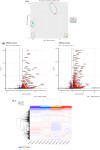Transcriptomic analysis of DENV-2-infected human dermal fibroblasts identified potential mechanisms that suppressed ZIKV replication during sequential coinfection
- PMID: 40399994
- PMCID: PMC12096689
- DOI: 10.1186/s12985-025-02769-9
Transcriptomic analysis of DENV-2-infected human dermal fibroblasts identified potential mechanisms that suppressed ZIKV replication during sequential coinfection
Abstract
Dengue virus (DENV) and Zika virus (ZIKV) are closely related flaviviruses which are transmitted by the same species of mosquitoes. Due to overlapping geographic distributions and transmission vectors, cases of DENV-ZIKV coinfection have been reported. However, the impact of coinfection on disease outcomes remains unclear. In this study, an in vitro model of DENV-ZIKV coinfection was developed using the primary human dermal fibroblasts (HDFs). The interaction between DENV-2 and ZIKV during sequential coinfection revealed that prior DENV-2 infection significantly suppressed ZIKV RNA accumulation in the culture supernatant. Transcriptomic profile in response to DENV-2 infection suggested three hypothetical pathways that potentially interfere with ZIKV replication. The first mechanism is prior DENV infection drove HDFs into an antiviral state through upregulation of genes involving innate immune response pathways, including PRR signaling, type I and type II IFN signaling, ISG activity, and cytokine/chemokine activity. This state significantly enhanced resistance to subsequent ZIKV infection in both infected cells and uninfected neighboring cells. The second potential pathway is inhibition of viral entry. This was supported by DENV-2-infected HDFs significantly suppressed expression of ZIKV receptor and reduced expression of genes involving in clathrin-mediated endocytosis. This can interfere with entry of ZIKV into host cells. The last possible mechanism is driving cells into cell cycle arrest, as DENV-2 infection downregulated genes related to cell cycle progression, which may hinder ZIKV replication. These findings partly unfold the interplay between DENV and ZIKV at the entry site which may explain the disease outcome of DENV-ZIKV coinfection.
Keywords: Coinfection; Dengue virus; Human dermal fibroblasts; Superinfection exclusion; Transcriptomic profiling; Zika virus.
© 2025. The Author(s).
Conflict of interest statement
Declarations. Ethics approval and consent to participate: Not applicable. Consent for publication: Not applicable. Competing interests: The authors declare no competing interests.
Figures






Similar articles
-
Sequential macrophage DENV and ZIKV infection shows differential expression of CD86, IFN-β, and regulation of TNF-α and IL-1β depending on DENV serotype.Braz J Microbiol. 2025 Jun;56(2):1083-1094. doi: 10.1007/s42770-025-01639-4. Epub 2025 Feb 19. Braz J Microbiol. 2025. PMID: 39969815
-
Pharmacological inhibition of the RhoA pathway by melatonin reduces viral replication and proinflammatory response against ZIKV and DENV-4 neuroinfections.Front Immunol. 2025 Aug 1;16:1630116. doi: 10.3389/fimmu.2025.1630116. eCollection 2025. Front Immunol. 2025. PMID: 40821819 Free PMC article.
-
A MicroRNA Screen Identifies the Wnt Signaling Pathway as a Regulator of the Interferon Response during Flavivirus Infection.J Virol. 2017 Mar 29;91(8):e02388-16. doi: 10.1128/JVI.02388-16. Print 2017 Apr 15. J Virol. 2017. PMID: 28148804 Free PMC article.
-
Immune Evasion Strategies Used by Zika Virus to Infect the Fetal Eye and Brain.Viral Immunol. 2020 Jan/Feb;33(1):22-37. doi: 10.1089/vim.2019.0082. Epub 2019 Nov 5. Viral Immunol. 2020. PMID: 31687902 Free PMC article. Review.
-
Congenital Zika syndrome: Pitfalls in the placental barrier.Rev Med Virol. 2018 Sep;28(5):e1985. doi: 10.1002/rmv.1985. Epub 2018 May 15. Rev Med Virol. 2018. PMID: 29761581
References
Publication types
MeSH terms
LinkOut - more resources
Full Text Sources
Medical

